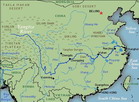2020 Yangtze River Cruise and Ferry Starting from 79 USD p.p.!
WHAT TO SEE IN JIUJIANG
Sycamore trees line the streets
of Jiujiang. The old downtown area is not large,sandwiched
between Gantang Lake and the river bank. The
old foreign concession area abuts the river
steamer dock and some old buildings remain--a
church, the old French hospital and the Council
House (now the Bank of China).
Crunchy, sweet Jiujiang tea biscuits
made from tea oil, sesame and orange osmanthus
flower originated in the Song dynasty, so did
the potent, strange tasting local wine, FenggangJiu,
made from glutinous rice and fermented in sealed
vats for five years.
GAN TANG LAKE (GAN TANG HU) AND YAN
SHUI PAVlLION (YAN SHUI TING)
Gantang Lake was divided into two
by a dyke and bridge built in 821 during the
Tang dynasty.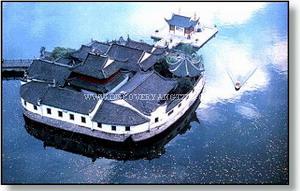 Sixian Bridge, now enlarged, still stands on
the causeway which one crosses to reach Yangyue
Pavilion on the low hill overlooking the lake.
It is well stocked with silver and grass carp,
and seagulls skim its surface. lt is said that
in the Three Kingdoms period (220--265) the
Eastern Wu general, Zhou Yu, inspected his warships
from a reviewing platform on the Lake, trees
of which remain.
Sixian Bridge, now enlarged, still stands on
the causeway which one crosses to reach Yangyue
Pavilion on the low hill overlooking the lake.
It is well stocked with silver and grass carp,
and seagulls skim its surface. lt is said that
in the Three Kingdoms period (220--265) the
Eastern Wu general, Zhou Yu, inspected his warships
from a reviewing platform on the Lake, trees
of which remain.
Linked to the shore by a zigzag
bridge is the pretty Yanshui (Misty Water)Pavilion.
A pavilion was first built here in the Tang
dynasty (618--907) by the poet Bai Juyi during
his unhappy posting in Jiujiang. It was named
the Drenched Moon Pavilion after a line from
one of his poems:'Bidding farewell I saw the
moon drenched by the river.'
In the Northern Song period (960--1127)
a highly regarded Neo-Confucian philosopher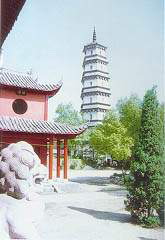 ,
Zhou Dun, taught in Jiujiang and his son built
a pavilion on the lake to his father's memory,
calling it Yanshui Pavilion. The present island
pavilion dates from the late Qing period (1644--1911).
One small hall is dedicated to BaiJuyi, another
rooms display local archaeological discoveries.
The city's antiques store is located here.
,
Zhou Dun, taught in Jiujiang and his son built
a pavilion on the lake to his father's memory,
calling it Yanshui Pavilion. The present island
pavilion dates from the late Qing period (1644--1911).
One small hall is dedicated to BaiJuyi, another
rooms display local archaeological discoveries.
The city's antiques store is located here.
NENG REN TEMPLE (NENG
REN SI)
The Qing halls here are the oldest
buildings left in jiujiang, although this Yuan-dynasty
Buddhist temple was established earlier, in
the sixth century. Three or four monks and several
nuns tend the temple. The seven-storey Great
Victory Pagoda, beside the temple, dates from
the Song period (960--1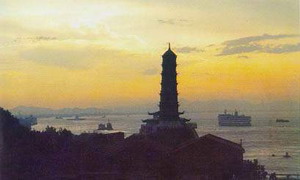 279).
279).
SUO JIANG PAGODA (SUO
JIANG TA)
This hexagonal seven-storey pagoda,
overlooking the Yangtze embankment to the north-east
of the city, was built in 1585. Damage to the
35-metre (115-foot) high pagoda caused by she1ling
from Japanese gunboats in World War II is still
visible.
WAVF WELL (LANG JING)
Near the waterfront is a small ancient
well with a quaint history. Dug early in the
Handynasty 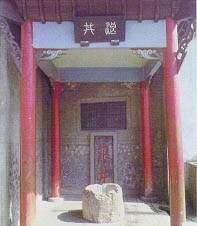 (206BC-AD
220), it connected with the Yangtze so that
When a wind created waves on the river the surface
of the well water would Tipple too. The well
became clogged and disused over the years until
it was rediscovered in the third century, and
the original inscription and date were uncovered.
This was such a good omen that the well was
renamed Auspicious Well. The poet Li Bai in
the eighth century referred to it as the Wave
Well in one of his poems, as did Su Dongpo.
Waves no longer appear on lts surface but the
well is still in use.
(206BC-AD
220), it connected with the Yangtze so that
When a wind created waves on the river the surface
of the well water would Tipple too. The well
became clogged and disused over the years until
it was rediscovered in the third century, and
the original inscription and date were uncovered.
This was such a good omen that the well was
renamed Auspicious Well. The poet Li Bai in
the eighth century referred to it as the Wave
Well in one of his poems, as did Su Dongpo.
Waves no longer appear on lts surface but the
well is still in use.
DONG LIN TEMPLE (DONG LIN
SI)
Twenty-two kilometres (13.5 miles)
southwest of Jiujiang at the foot of Lushan
is the Donglin (Eastern Forest) Temple, built
in 386 for the monk Hui Yuan (334--416),founder
of the Pure Land sect of Buddhism, whose overgrown
grave is behind the temple. He spent many years
translating Buddhist scriptures, and among his
123 disciples were an Indian and a Nepali. The
temple reached its zenith in the Tangdynasty
(618--907), with a vast library of scriptures
and over 300 halls and residences. Seriously
damaged during the Taiping Rebellion (1850--64),
the temple was almost ruined in the Republican
period (1911-49). Today there is a community
of 20 monks who hold daily services in the temple
halls. Behind the temple in a bamboo grove is
the Well of Intelligence--from which every visitor
is anxious for a sip. The Luohan Pine trees
in the courtyard are said to have been planted
by Hui Yuanhimself. Hui Yuan is also said to
have struck the ground with his staff, causing
the Ancient Dragon Spring to gush forth, thus
proving his right to establish himself here.Nearby
is the Xi Lin Pagoda(Xi Lin Ta), all that remains
of an earlier temple complex.
• JiuJiang and
its history
• What to see in Jiujiang
• Lushan
• Stone
Bell Hill
• Dragon
Palace Cave & Poyang Lake

